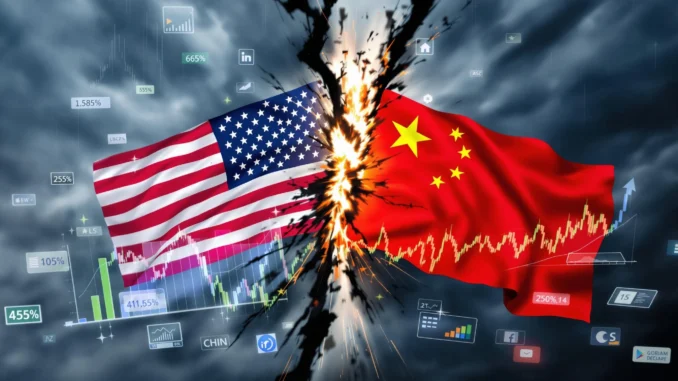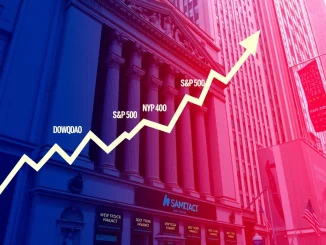
Hold onto your hats, folks! The trade winds just got a whole lot stormier. In a move that has sent ripples through global markets, U.S. President Donald Trump has doubled down on his trade tactics, increasing tariffs on Chinese imports by another 10%. Yes, you read that right. Just when we thought the trade tensions couldn’t get any higher, they did.
What’s the Deal with These New China Import Tariffs?
Let’s break down this latest development. President Trump has amended an Executive Order from last month, adding a significant 10% to existing tariffs on goods coming from China. According to reports, this pushes the total tariff burden on Chinese imports up to a hefty 20%. This isn’t just a minor tweak; it’s a substantial escalation in the ongoing trade friction between the world’s two largest economies.
Think of it like this:
- Initial Tariffs: Already in place on a range of Chinese goods.
- Previous Increase: Tariffs were already increased last month.
- New 10% Hike: This latest EO adds another 10% on top of everything.
- Total Impact: Many Chinese imports now face a 20% tariff when entering the U.S.
This move is sure to have wide-ranging consequences, not just for businesses directly involved in US-China trade, but potentially for the entire global economy impact. But what exactly does this mean for you, and for the markets you care about?
The Ripple Effect: How Trump Tariffs China Could Shake the World
Increased tariffs are rarely isolated events. They tend to create a cascade of effects, touching various sectors and markets. Here’s a look at some potential repercussions of these new Trump tariffs China:
- Increased Costs for Businesses: American companies that rely on Chinese imports for parts, materials, or finished goods will face higher costs. These costs might be passed on to consumers, leading to inflation.
- Retaliation from China: Trade wars are often tit-for-tat. China may retaliate by imposing tariffs on US goods, impacting American exporters and industries like agriculture.
- Supply Chain Disruptions: Businesses may need to rethink their supply chains, seeking alternative sources outside of China, which can be costly and time-consuming.
- Market Volatility: Uncertainty surrounding trade policies often leads to increased volatility in financial markets, including stock markets and potentially cryptocurrency markets.
- Slower Economic Growth: Trade disputes can dampen global economic growth by reducing trade volumes and investment.
For those invested in cryptocurrencies, the broader market reaction to these tariffs is crucial. Traditional markets often influence the crypto space. Economic uncertainty and market volatility can sometimes drive investors towards alternative assets like Bitcoin, but it can also trigger risk-off sentiment across the board.
US Trade War: Are We Heading for a Full-Blown Conflict?
The term “US trade war” has been thrown around for some time, and this latest tariff hike certainly feels like another escalation. Are we moving closer to a full-blown trade war? It’s a question on many minds. A full-scale trade war could involve:
- Widespread Tariffs: Tariffs imposed on a vast range of goods and services by both countries.
- Non-Tariff Barriers: Increased use of other trade barriers like quotas, regulations, and bureaucratic hurdles.
- Geopolitical Tensions: Trade disputes can spill over into other areas of international relations, increasing geopolitical tensions.
- Long-Term Economic Damage: Prolonged trade conflicts can inflict lasting damage on both economies, hindering growth and innovation.
While the immediate impact of these China import tariffs is being assessed, the long-term implications for global trade and economic stability are significant and warrant close attention.
Navigating the Uncertainty: What Can You Do?
In times of economic uncertainty, knowledge is power. Here are some actionable insights to consider:
- Stay Informed: Keep up-to-date with developments in the US-China trade relationship and global economic news.
- Diversify Investments: Diversification can help mitigate risk in volatile market conditions.
- Consider Long-Term Strategies: Focus on long-term investment strategies rather than reacting impulsively to short-term market fluctuations.
- Seek Expert Advice: Consult with financial advisors to understand how these developments might affect your portfolio and financial plans.
The Bottom Line: Trade Tensions on the Rise
President Trump’s decision to increase tariffs on Chinese imports by another 10% is a significant move that intensifies the existing trade dispute. The full consequences of this action are still unfolding, but it’s clear that businesses, consumers, and investors need to be prepared for potential market volatility and economic shifts. As the global economy impact becomes clearer, staying informed and adaptable will be key to navigating these turbulent times. Will this lead to a resolution or further escalation? Only time will tell, but one thing is certain: the trade war saga continues.



